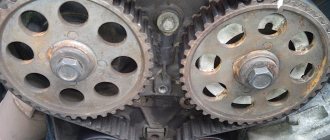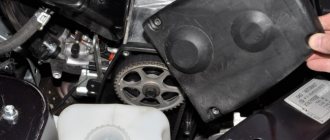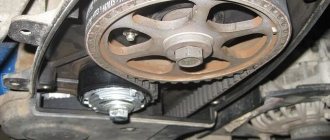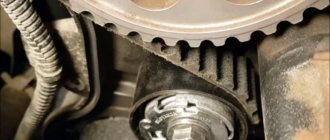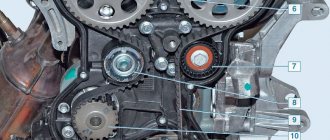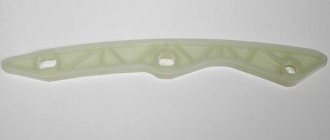It is necessary to replace the timing belt on the Largus (16 valves) according to the maintenance card. The condition of the belt drive determines how accurately the gas distribution in the engine will be carried out. Motion is transmitted from the crankshaft via a flexible belt to the liquid pump and distribution mechanisms.
When repairing, be sure to pay attention to all related elements. If there is a malfunction of the liquid pump, or the camshaft pulleys are severely worn, it is necessary to replace these elements. Buy spare parts only from trusted manufacturers and reputable sellers.
Diagnostics of the mechanism
But before replacing the timing belt on the Lada-Largus (16 valves), you need to make sure that it has already exhausted its service life or is damaged. It is advisable to carry out inspection every 10 thousand km.
No special tools are required for repairs; a visual inspection is sufficient:
- Pay attention to whether there are any cracks on the surface of the belt. If they are present, they may increase during operation, which will lead to belt breakage.
- If there is excessive wear on the outer or inner surfaces, the belt must be replaced.
- Pay attention to whether there are delaminations.
- Assess the condition of the teeth.
- There should be no signs of wear or abrasions on the side surfaces.
- The tension should be normal. Check it out using the signs on the video.
- If there are oil stains on the elements of the gas distribution mechanism, this indicates the presence of breakdowns.
Replacing the belt on the 8-valve version
The 8-valve engine has a simpler design and only one camshaft, so the process of removing the drive belt and its subsequent installation is a little simplified here. In general, the procedure itself is not particularly difficult and even a novice car enthusiast can perform it if he has the necessary tools: a set of keys, hexagons, screwdrivers, as well as a special device for tensioning the belt. Although you will have to tinker a little in the garage.
Removal
To work, you will need a lift or inspection pit. First you need to disconnect the battery and jack up the car a little in the front - you will have to remove the front right wheel. If the car has a K7M engine, then you must also first disconnect the inlet pipe. Next you need to remove the wheel and crankcase protection. Next, the right engine mount is unscrewed. The engine weighs more than 100 kg and can easily cause injury if dropped. To prevent this from happening, be sure to place a jack under its bottom before starting work. Lower the engine slightly to reach and remove the timing belt covers. Immediately after removing the wheel, it is necessary to remove the crankcase protection, unscrew the fasteners on the pulley and remove it from the crankshaft. In this case, engage fifth gear and press the brake pedal all the way. To remove the belt from the cylinder, it is necessary to set the latter in the appropriate position. You need to rotate it until the mark shows that it is in the TDC position. On some models of power units there is a special symbol - the Latin letter D. This is necessary to fix the crankshaft in the locking groove. The last step is to loosen the nut on the roller and dismantle the belt itself. You need to remove it from under the roller, and then sequentially from the gear, pump and pulley.
Installation of a new belt on Lada Largus
Once the old belt is removed, a new one is installed in its place. But first you need to carefully examine other timing components; perhaps they are also involved in the rapid wear of the part being replaced. If everything is in order and the service life of the belt has come to an end, according to the regulations, then a new one is installed. The location of the arrows on the new product indicates the direction of rotation of the mechanism. The procedure for installing the belt is as follows:
- crankshaft pulley,
- water pump,
- camshaft pulley,
- tension roller.
Next, tension is carried out using a special wrench until the marks are level with each other. At this point, the belt installation process is completed and all that remains is to assemble the motor and check its performance.
What else should I do when replacing the timing belt?
If you decide to replace the timing belt on a 16-valve engine, it is advisable to check the condition of all system components to ensure they are in good condition. If there are extraneous sounds when the engine is running, this is clearly a symptom that the timing belt and rollers need to be replaced. These components are changed in any case, but the pump and pulleys have a slightly longer service life. In particular, pulleys can last at least 120 thousand km, and this is a considerable mileage. But usually they “walk” much longer.
Which timing belt to choose for Lada Largus
In addition to the correct procedure for replacing the drive belt, the quality of the parts purchased has a significant impact on its service life.
For an 8-valve engine, the choice of timing belts is quite varied. AvtoVAZ is considered the official supplier.
Among the substitutes were products from companies such as Bosch, Pilenga, Dayco, SKF and a number of others. Reviews from owners about the actual characteristics of products from various manufacturers are quite contradictory, so for cars under warranty you should follow the recommendations of official dealers, and in other cases rely on your own experience.
16-valve Lada Largus engines in the original configuration are equipped with a belt 117206842R GATES 6 RK 1822, the cost of which is an order of magnitude higher than that of its 8-valve counterpart. The replacement kit includes the drive belt itself, a tensioner and a idler pulley.
When should a fluid pump be replaced?
When replacing the timing belt on a Lada-Largus, be sure to take into account the fact that the liquid pump has a service life of no more than 100 thousand km. Antifreeze of any brand has a similar service life. During this mileage, all the additives contained in it evaporate, which leads to a decrease in the efficiency of the entire engine cooling system.
Therefore, if the service life of the liquid pump has already expired, then it is advisable to fill in fresh antifreeze and install a new pump. And if the car is operated in a gentle mode, a mileage of 60 thousand km is achieved in several years, then the elements of the gas distribution system, pump and antifreeze must be changed at least once every two years. Replacing the timing belt on the Largus (16 valves) must be treated with great attention, since the system is complex and the slightest desynchronization of the shafts will lead to a disastrous outcome.
Replacing the belt in the 16-valve version
With a 16-valve engine, replacing the belt will require a little more effort, and most importantly, the presence of additional parts and devices: fixing plates and pins, as well as plugs for the end of the cylinder head and closing camshaft limit switches. To gain access to the timing belt, you need to go through similar steps as with an 8-valve engine:
- placing on the pit and disconnecting the battery terminal;
- removing the right front wheel, as well as the car crankcase protection;
- removing the auxiliary drive belt and unscrewing the spark plugs;
- jacking the engine to securely fix it in one position.
Next, in the hood space, the fastening elements of the timing drive are unscrewed and its top cover is removed. The pulley can also be operated by engaging 5th gear and pressing down the brake pedal. Having secured the crankshaft from turning, using a pry bar for this, and unscrewing the fastening element, the camshaft pulley is dismantled, and the bolt holding it with a pair of nuts must be screwed back in. The bottom cover is removed to gain direct access to the timing mechanism. Then a resonator is taken out to supply air. At the end of the head (it is located on the flywheel side) two plugs are knocked out. You can do this with a regular screwdriver. Now you need to set the 1st and 4th cylinders to the TDC position. The crankshaft is rotated until the grooves on the camshaft ends are horizontal. They need to be fixed in this position using a pre-prepared plate. The crankshaft may spin. To eliminate the problem, a pin is installed on a special plug on the block. The pin will serve as a kind of lock, preventing the shaft from turning, the main thing is that it goes into the hole all the way.
Alternative method
There is also an alternative replacement method that does not require a plate or pins, but does require the assistance of another person. He will have to insert thin metal spokes into the spark plug holes of the 1st and 4th cylinders, while holding them strictly vertically. Next, the crankshaft rotates until the Renault logos are in the correct position, namely on the top on the left pulley and on the right on the bottom. By looking at the spokes, it will be possible to determine the moment when the pistons reached TDC and further scrolling leads to their lowering. Once the parts are in the correct position, it is advisable to mark this with a felt-tip pen or paint on the camshaft and flywheel housing.
Belt removal
You need to loosen the nut on the roller and carefully dismantle it and remove the drive element itself from it. Next, it is disconnected from the pump, crankshaft and camshaft. It is first advisable to loosen the tension a little by turning the structure in the opposite direction to the marks indicated on the belt.
Belt attachment in a 16-valve Largus unit
Installing the belt is also easy. Everything is done in the same order as in the case of an 8-valve engine. In this case, you need to put the drive belt on the roller in advance and only then return the mechanism to its place, sequentially putting the element on the crankshaft, pump and camshaft. When installing, again you need to pay attention to the arrows - they should be directed in the direction of rotation. If the work is carried out without the use of additional fixing devices, then an assistant will be needed when installing the belt. When putting the drive element on the camshaft pulleys, they need to be aligned according to the previously left marks. To perform the procedure, turn the camshafts with keys until they are aligned with the marked marks. It is necessary to hold the mechanism in a given position while the belt is tensioned on it. It is impossible to complete this sequence of actions alone, so you need a partner.
Preparatory work
If you forgot when you changed the timing belt on the Largus (16 valves), it’s better to carry out the repair. If you do not want to make the replacement yourself, contact a service station. To repair on your own, you will need to do the following preparatory work:
- Disconnect the negative wire from the battery. This will ensure that your vehicle is fully powered.
- Disconnect the inlet pipe, and then remove the drive belt of the generator and other auxiliary mechanisms.
- The support on the right side of the engine will interfere with you, so it must be removed.
- The protection cover consists of lower and upper halves. They must be removed by unscrewing the mounting bolts.
That's all, the preparatory work is finished. You can begin replacing the timing belt on the Largus (16 valves).
Time frame for replacing the timing drive: according to regulations and real experience
Of course, you can rely on high-quality belt material and modern manufacturing technologies and carry out replacement according to regulations. However, the experience of Largus owners suggests that it is better to reduce this period by half. Otherwise, there is a high probability of an unexpected breakdown, and then you will have to use a tow truck to get to the nearest car service center.
So, based on the results of actual operation, taking into account Russian climatic conditions, it is recommended to replace the Lada Largus timing belt at intervals of 60 thousand kilometers.
Brake system
Checking the fluid level in the reservoir++++++++++Checking the condition of the brake discs and pads of the front wheels++++++++++Checking the condition and cleaning of dust from the brake mechanisms of the rear wheels———+——— +——Replacing brake fluid*** (instructions)—————+————Answers (2)
The timing belt and rollers in engines of this model are replaced at 120 thousand km (after 6 years of operation). However, we recommend that you inspect the condition of the timing belt and rollers once a year, because during operation, oil or dirt may get on the belt, in which case the belt must be urgently replaced.
They write differently, who to believe, the answers vary from 120,000 in the service book to 60,000 they say at the Renault service station, I changed it at 75,664 km at the Renault service station, my removed belt was like new, no cracks or stripes anywhere, but what kind of videos? In general, reluctantly from the money spent, I changed it because... There were long routes ahead, and a new one is a new one.
Not so long ago, the Largus station wagon from the Tolyatti company Lada, which appeared on the Russian market, managed to acquire high demand, so many owners of this model are interested in the question of how and when to change the timing belt.
Chassis
Checking the condition of the tires and their pressure++++++++++Checking the condition of the ball joints and silent blocks of the suspension arms++++++++++Checking the condition of the front and rear shock absorbers+++++++ +++Tools for repairs
In order to replace the timing gear drive of a 16 valve engine, you will need the following tools:
- A set of spanners, sockets, ratchets and extensions.
- Several screwdrivers.
- Special mandrels for crankshafts and camshafts.
- Special key for belt tension.
Purchase a repair kit in advance. It includes the belt itself and rollers. If the pulleys on the shafts and the pump are heavily worn, then it is necessary to purchase these elements.
Checking and tensioning the belt
A few words about the process of belt tensioning. On a 16-valve engine, tension is checked by inspecting the tensioner.
There are indicators on it that must be aligned during normal tension of the drive element.
If the upper pointer moves to the side, this indicates a loose or overtightened belt.
To adjust the tension, you need to loosen the roller nut and use a hexagon to turn the roller so that the pointers align.
In 8-valve units, tension is checked by hand. To do this, we take the belt with our fingers in the middle of the area between the camshaft pulley and the pump (K7M) or the crankshaft gear (VAZ) and try to rotate it around the axis.
For a normally tensioned belt, the rotation angle should not exceed 90 degrees. Below is shown using the example of a VAZ 2110.
If the angle of rotation is too small or large, we tighten it by loosening the nut of the tension roller and turning the roller itself with a special wrench.
Motor line of the Largus model
Over the years, 8 and 16 valve French and domestic engines were installed on the Lada heel. Although today engineers prefer to use only Russian units, there are still many Largus with Renault engines driving on the country's roads. So, during the entire production period, four types of internal combustion engines were used in the model:
Each of these engine types has its own characteristics that affect the belt replacement process. We will dwell on these nuances in detail below, but for now we will only note that it will be a little easier for owners of the 8-valve version to complete the necessary work.
Prices and articles, originals and analogues of belts for Lada Largus
For 8-valve versions of Lada Largus, manufacturers offer a wide range of options. The article number of the original timing belt kit from Renault for the 8-valve K7M engine is 130C17480R. The kit includes a tension roller. The price tag starts from 2,500 rubles.
Gates has long been the official supplier of components for VAZ cars. As analogues, you can also choose belts from the brands Bosch, Dayco, SKF, etc.
If a Largus with a 16-valve engine is still under warranty, then the most correct solution would be to install a timing belt kit with catalog number - 117206842R GATES 6 RK 1822. The price for it starts from 4,300 rubles, which is significantly higher than the cost of the belt used in Timing belt variations Largus with an internal combustion engine with 8 valves.
The cost of the timing belt itself, manufactured by Renault, for both the K7M and K4M engines starts from 800 rubles. Price lists for taxes can be found below.
What should you choose? The only thing that can be recommended is to purchase a belt as a set, the original one - Renault, or from Gates.
Replacing the timing belt is absolutely not a complicated procedure, so you should not skimp on such an important consumable component for the engine. A couple of thousand rubles are completely incommensurate with the financial losses in the event of a timing belt drive breakage.
Types of drive belts
Depending on the configuration, the Largus is equipped with power steering or air conditioning; the power plant can be 16- or 8-valve. Accordingly, different products are used:
- Renault 117200593R (6PK 837) – standard poly-V-ribbed six-ribbed belt used on an 8-valve power unit without power steering, with air conditioning;
- model 4PK715 (four-strand, length 715 mm) - used on an eight-valve engine without power steering and without an air conditioning system;
- the eight-valve K7M engine uses a five-valve 5PK 1110, length - 1110 mm, power steering and air conditioning are also not installed on this engine;
- K4M engine (16-valve) - a six-strand 6PK 1200 with a length of 1200 mm is used, an engine without air conditioning, with power steering.
- power units equipped with power steering and air conditioning (8 and 16 valves) are equipped with a six-stream 6RK 1820 with a length of 1820 mm.
The approximate cost is set from 300 to 400 rubles for short ones, and up to 800 for long ones.


